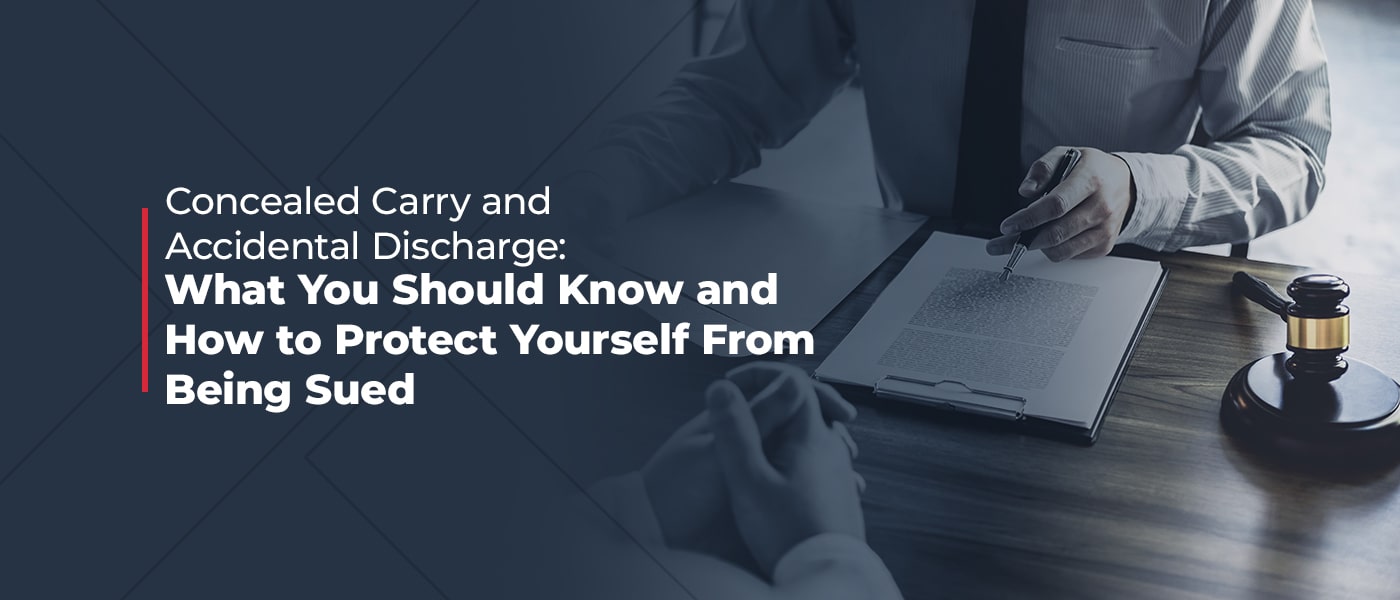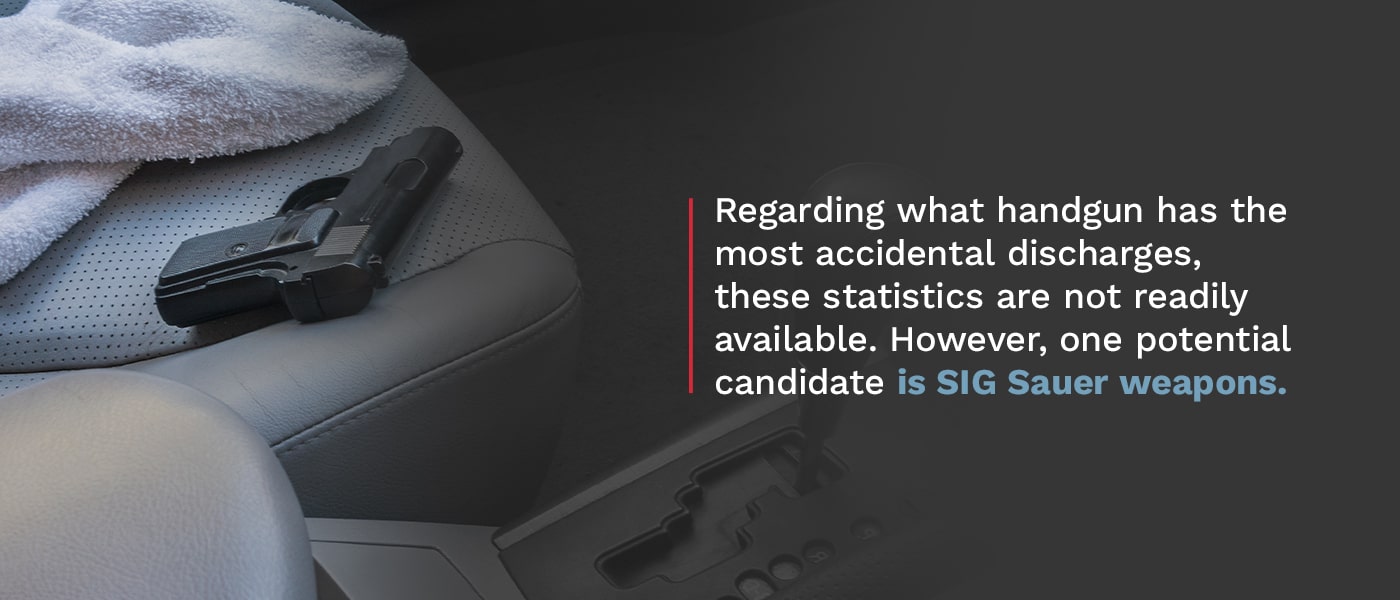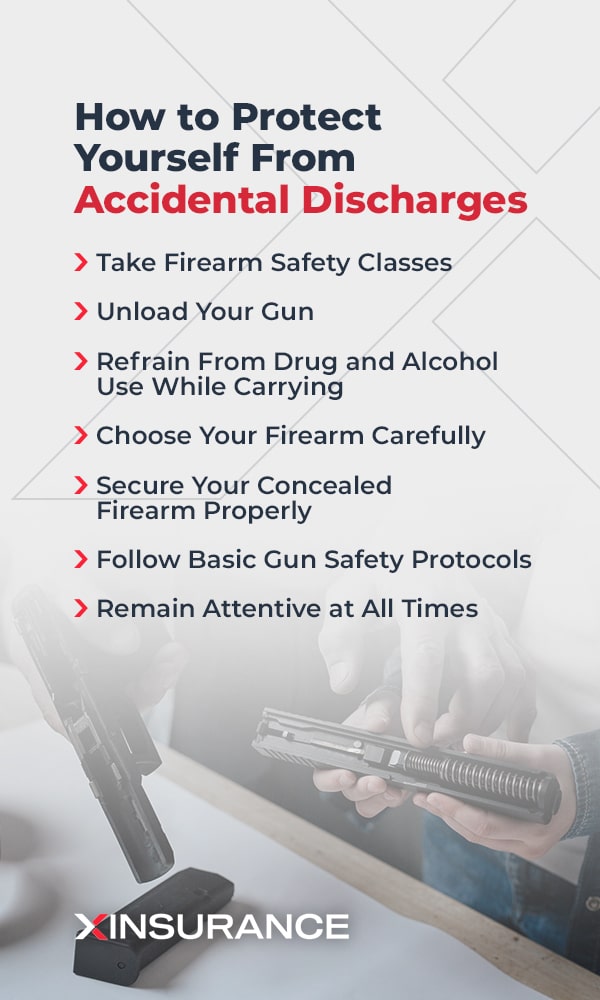
Concealed Carry and Accidental Discharge: What You Should Know and How to Protect Yourself From Being Sued
In the United States, 45,222 people die from firearm injuries every year, according to the U.S. Centers for Disease Control and Prevention (CDC). But how common are accidental discharges?
More than a few of those cases involve accidents. The National Safety Council reports that about 1% of all gun deaths are preventable, unintentional discharges. That figure may sound small, but it amounts to about 535 accidental gun deaths a year, as well as many more injuries. That means more than one person dies from an unintentional firearm discharge every day.
In many ways, accidental firearm discharge is a public health issue — it affects the health and safety of a significant portion of our population. Fortunately, you can take several steps to protect against accidental discharge and avoid these highly preventable injuries.
Common Causes of Concealed Carry Accidental Discharges
Let’s look at a couple of concealed carry statistics before we begin talking about accidental discharges. Over the past couple of decades, the number of concealed carry permits has soared. In 2007, the number of concealed handgun permits in the United States was a relatively modest 4.6 million. As of 2021, that number has climbed to 21.52 million — and some states do not require permits for concealed carry.
Concealed carry accidental discharge statistics are not readily available. In 2020, the research organization known as the RAND Corporation investigated the correlation between shall-issue concealed carry permit laws and unintentional gun injuries and deaths and found the evidence too inconclusive to draw meaningful inferences from.
Nevertheless, with concealed carry, an accidental discharge is a possibility. Let’s explore a few of the reasons.
1. Inexperience
Many accidental firearm discharges occur due to inexperience. In some cases, the person has never carried a firearm before. In others, the person has a certain level of firearm experience — perhaps just enough to feel confident — but not enough to ensure competence with safe concealed carry. The person may never have taken a formal firearms training course.
It is no coincidence that most accidental gunshot victims are younger than 24. The shooter is usually someone about the victim’s age — so also relatively young and likely inexperienced. Being careful with weapons, including concealed weapons, is critical around children and young adults, especially in America’s schools. That is why many school communities prohibit weapons of any kind on their grounds.
A person who lacks proper experience with concealed weapons may fail to take the necessary security measures. They may unholster their guns and place them in areas where they could easily fall, discharge, and hurt someone. Or they may intend to engage the safety catch but forget to do so.
In a surprisingly high number of cases, that inexperience comes to light when gun owners are in the restroom. Gun owners carrying concealed weapons may sometimes accidentally grasp their guns as they reach for their pants. In some cases, they may actually grab their weapons to use as leverage. If neither of these scenarios occurs, the firearm may still fall to the ground and discharge while the person’s belt is loosened.
More experienced firearm owners know how to avoid these potentially costly and tragic errors.
2. Improper Storage
Improper storage might occur if someone carrying a concealed weapon removes it and stores it somewhere else temporarily — again, often when the person is in the restroom.
Some gun owners unholster their firearms and put them in unsafe places while they use the restroom. A person might put the weapon on top of the toilet paper dispenser or on the back of the toilet, where it could easily become unbalanced, fall, and accidentally discharge.
Improper storage can also mean failing to wear a holster during concealed carry. Some firearm owners merely tuck their guns into their waistbands. However, using a proper holster can be safer because holsters prevent accidental trigger contact.
Inadvertent gun discharges can still sometimes occur with holsters — if something gets stuck inside and interferes with the trigger, for instance. In general, though, holsters are designed to protect against these concealed carry accidents.
If you choose not to stow your gun in a holster for concealed carry, consider investing in a quality trigger shield that can protect against accidental discharge.
3. Carrying While Under the Influence
Carrying a firearm while under the influence of alcohol or drugs can dramatically increase the chances of an accidental discharge. Almost a quarter of all unintentional firearm deaths involve alcohol consumption. Among individuals aged 20 to 29, that figure rises to 46.8%.
A person who has consumed an alcoholic beverage or several is much more likely to fumble with their weapon and drop it in a way that could cause it to discharge. Someone under the influence might also accidentally pull the trigger and injure or kill another person.
4. Using the Wrong Weapon for the Experience Level
Regarding what handgun has the most accidental discharges, these statistics are not readily available. However, one potential candidate is SIG Sauer weapons.
SIG Sauer is an elite German handgun brand very popular with law enforcement and military personnel. The gun’s design and function are optimized for use by these highly trained professionals. They need to be able to discharge their weapons quickly, often at a split-second’s notice, and they have the training and expertise necessary to manage their weapons safely. SIG Sauers give them the precision and split-second response they need to do their jobs effectively and save lives.
SIG Sauer firearms have several features designed to make them easier for law enforcement officers to use:
- Absence of a safety mechanism on certain models
- A manufacturer-issued trigger pull of only 4.4 pounds of force in single-action mode — one of the lightest available
- An unlabeled decocking lever, even though the decocking lever is necessary for disengaging single-action mode
In the hands of less experienced civilians, however, the same features can prove deadly. A civilian without the training required to manage a hair-trigger response may become more prone to accidentally discharging the weapon.
Numerous inadvertent SIG Sauer discharges have occurred over the years. Some police officers have accidentally caused their SIG Sauer weapons to discharge when they dropped them or while holstering them.
These incidents are hardly limited to law enforcement personnel. Civilians who own SIG Sauers have accidentally discharged them as well. One SIG Sauer owner discharged his shoulder-holstered firearm in the restroom when his shirt fabric accidentally engaged the trigger, for example.
More rigorous research is likely necessary to determine which firearms are more susceptible to accidental discharge and at what rates. However, the most important thing is to know how accidental discharges are likely to occur, how to prevent them from happening, and how to protect yourself from liability if they do occur despite your best efforts.
How to Protect Yourself From Accidental Discharges
Below are a few ways to prevent accidental concealed carry discharges:
1. Take Firearm Safety Classes
One of the best ways to protect yourself from accidentally discharging your concealed weapon is to take formal training in the use of a firearm. According to the RAND Corporation, about 61% of gun owners in the United States have received some formal firearms training. A safety class helps you learn the best techniques for securing and carrying a gun that will less likely lead to accidents.
Firearms courses generally cover many of the basic safety protocols necessary to protect the gun owner and other people. Most firearms instructors cover topics like these:
- Proper firearm storage
- Loading and unloading the weapons
- Operating the safety mechanism
- Safely clearing cartridges and jams
- Avoiding accidental discharges by keeping the trigger finger away from the trigger until the person is ready to fire
This instruction can make the difference between safe gun carrying and carrying situations that could endanger other people.
2. Unload Your Gun
Some firearm owners prefer to carry loaded weapons. After all, loading a gun takes time, and having to stop and load could significantly slow a person’s reaction in an active shooter scenario.
However, carrying an unloaded gun is often the safest option. An unloaded weapon is guaranteed not to cause injuries or fatalities, even if you drop it or jostle it in a way that accidentally engages the trigger. Even if you forget to engage the safety catch on an unloaded weapon, you can still be sure your gun will not fire and hurt someone.
3. Refrain From Drug and Alcohol Use While Carrying
As we’ve seen, firearms and drug and alcohol use do not mix well. To minimize the likelihood of accidentally discharging your weapon and potentially injuring or killing someone, you should always remain sober when you have a loaded firearm on your person.
If you are carrying a concealed weapon and find yourself in a situation where you feel inclined to partake of mind-altering substances, you have a few options at your disposal. You can abstain, of course. You can unload your weapon before you begin to partake, or you might remove your gun and give it to a trusted friend or family member. Just be sure that person has the good judgment and firearms experience necessary to remain safe.
4. Choose Your Firearm Carefully
Many people who carry concealed firearms want to know they are armed with superior protection. They want quality firearms they can rely on if they ever need them in a dangerous situation.
Nevertheless, gun owners should be responsible with their weapon choices. Individuals who do not have rigorous training with the highly responsive firearms designed for law enforcement should be realistic about their ability to handle these guns safely. Choosing a weapon that requires slightly more force to engage the trigger can mean the difference between carrying safely and responsibly or potentially causing a tragic accident.
5. Secure Your Concealed Firearm Properly
One simple but effective step you can take to prevent accidental discharges is to secure your concealed gun carefully whenever you carry it. Merely sliding your weapon into your waistband, for example, increases the likelihood that it could easily slip and fall out or that you could accidentally press against and engage the trigger.
To decrease that risk, consider using a holster for your weapon. If you do use a holster, always ensure there is nothing inside it that could come into contact with the trigger.
The necessity of securing your firearm properly also applies when you must remove your concealed weapon from its usual place on your body. If you need to use the restroom, be sure to secure your gun so it cannot fall and discharge. If you set your weapon down somewhere, always choose a broad, flat, stable surface to minimize the risk that your gun could slip off and fire upon impact with the ground.
6. Follow Basic Gun Safety Protocols
If you carry a concealed weapon, you may end up drawing it at some point. If you do, be sure to follow basic gun safety protocols:
- Never point your gun unless you intend to fire it.
- Be mindful of your target and everything behind it.
- Keep the safety catch engaged until you are ready to fire.
- Keep your finger away from the trigger until you are ready to fire.
Following these rules can help ensure you refrain from inflicting harm on an innocent bystander, even in the stress of the moment.
7. Remain Attentive at All Times
Some accidental discharges occur even when well-trained gun owners become distracted. Even a momentary lapse in attention could potentially lead to an accident. A distracted person carrying a weapon could brush against the trigger or move in a way that causes the gun to fall and fire. A distracted person who is carrying a loaded weapon but usually carries an unloaded weapon might forget to be very careful w
ith the loaded gun.
Maintaining attentiveness and vigilance at all times during concealed carry is critical. It enables gun owners to carry their weapons responsibly, without doing grievous harm to those around them.
Protect Yourself Financially With Coverage From XINSURANCE
At XINSURANCE, we are the brand with true peace of mind. As an insurance partner, we provide solutions such as firearm and concealed carry liability insurance coverage that gives you dependable protection if an accidental gun discharge occurs despite your best efforts.
Our all-in-one approach means we cover all your exposures under a single policy. You’ll have broader coverage with higher limits, and you’ll also have direct access to our teams of underwriters, risk management professionals, and claims management professionals — all in the same place.
We can offer you a free quote with a quick turnaround, and if you decide to work with us, you’ll have access to our claims hotline 24 hours a day, seven days a week. No risk is too big or too small — we handle everything from business insurance policies to individual policies. We want to work with you to get you the coverage you need.
Contact us today to learn more about a policy that would be right for you.

Rick J. Lindsey hails from Salt Lake City, Utah. He began working in the mailroom of his father’s Salt Lake City insurance firm, getting his introduction to the business that became his lifelong career. Rick J. Lindsey quickly rose through the ranks while working in nearly every imaginable insurance industry job. As an entrepreneur, specialty lines underwriter, claims specialist, risk manager, and a licensed surplus lines broker, Rick J. Lindsey is highly skilled in all levels of leadership and execution. As he progressed on his career path, Rick J. Lindsey discovered an urgent need for insurers willing to write policies for high-risk individuals and businesses. He was frequently frustrated that he could not provide the liability protection these entities desperately needed to safeguard their assets. He also formed the belief that insurance companies acted too quickly to settle frivolous claims. Rick J. Lindsey decided to try a different approach. He started an insurance company and became the newly formed entity’s CEO. This opportunity has enabled Rick J. Lindsey to fill a void in the market and provide a valuable service to businesses, individuals, and insurance agents who write high-risk business. XINSURANCE also specializes in helping individuals and businesses who live a lifestyle or participate in activities that make them difficult for traditional carriers to insure. If you’ve been denied, non-renewed, or canceled coverage, don’t give up quite yet. Chances are XINSURANCE can help.





